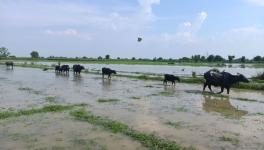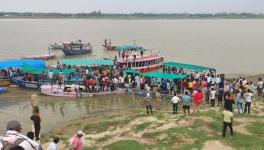Still a Massive Block in Flow of Funds to Save Rivers

Image Courtesy: The Quint
The Prime Minister Narendra Modi-led government has frequently propagated its commitment to protecting rivers. Above all, saving the river Ganga is its oft-cited priority. But is this claim matched by the government’s willingness to ensure adequate funds to protect rivers?
Let us consider the latest updated data regarding the flagship Namami Ganga Program and its funding. This program began with great fanfare when the freshly re-elected BJP government at the Centre took charge in 2019. It was declared as a project worth Rs.20,000 crores (one crore=10 million) that would be spent over several years. This project is regarded as a high-priority program of the central government.
However, as per the latest data from the Jal Shakti Ministry, posted by the Press Information Bureau on 26 July 2021, the financial allocation for Namami Gange was Rs. 3,023 crores in 2017-18. Since then, it has only declined more or less steadily. The government reduced the funding to Rs.2,370 crore in 2018-19, then to Rs.1,553 crore in 2019-20, and further to Rs.1,300 crore in 2020-21. In other words, the financial allocation in 2020-21 was just 43% of what it was three years back in 2017-18.
In 2021-22, Namami Gange has a budget of Rs.1,450 crore. It is a slight rise compared to the previous year, but still, the allocation for the latest year is only 47% of that in 2017-18.
To deny adequate funds is just one part of the problem. Note also that this much-publicised project started with a massive cut in funding. While the financial allocation for the first year of the Namami Gange Project was Rs.2,053 crores, official data shows the government of India released only Rs.326 crores to the National Mission to Clean Ganga. In other words, in its very first year, the funds released were only about 16%. It is regrettable, as the base or starting year sets the momentum for any largescale project. If the opportunity in the first year is lost, it is hard to imagine a pick-up in later years, especially as the Indian economy is not doing well.
Some may argue inadequate funding is only a result of teething problems that must get resolved. If this were so, the following year should have brought a much higher allocation. Jump-starting funding in later years is the only way to make up the vast deficit of the first year. However, this was even lower, at Rs.1,650 crore.
The year 2017-18 supposedly was the peak allocation for this project. However, only Rs.1,423 crore got released, just about 46% of the allocation. Overall, Rs.10,792 crores have been released so far for Namami Gange, compared with a budget of Rs.15,074 crore, as per data till 30 June 2021.
While the budgetary allocation for Namami Gange shows a significant declining trend, even the release of the funds is less than the actual set aside for the project. Further, the record of spending to protect other rivers is even more dismal. The Namami Gange Program under the Jal Shakti Ministry is restricted to protecting the river Ganga and its tributaries. All other rivers get covered by the National River Conservation Plan (NRCP), administered by the Ministry of Environment and Forests. Naturally, one would expect much higher allocations for a program that covers all rivers but one. Nevertheless, the share of this program (till 12 March 2020), as per data provided by the government in Lok Sabha, was only Rs.5,870 crore, of which the Centre contributed its share of only Rs.2,510 crores. It is clearly a very measly allocation for so monumental a task. It is not surprising that the project has tried to reduce pollution in only 34 rivers that flow through 16 states under this program.
The record is even more bleak considering the schemes sanctioned over the last three years. This is as per information provided in March 2020. Therefore, it would apply to schemes sanctioned between 2017 and 2020. Only four pollution control projects in four separate states are mentioned.
The most significant sanction of funds mentioned by the government is for a scheme on the Tapi River in Surat, Gujarat. This sanction is for an impressive-sounding Rs.971 crore, but the actual money released during the first year, March 2019 to March 2020, was just Rs.13 crores. So, less than 2% of the funds were released.
In September 2018, another scheme got sanctioned for the Devika and Tawi rivers in Jammu and Kashmir. In this case, the sanction of funds is for Rs.186 crores. However, only Rs.30 crores were released by March 2020. The actual expenditure (including state share) was, in fact, only Rs.13 crores.
In July 2018, Rs.95 crores were sanctioned to reduce pollution in the Rani Chu river in Gangtok, Sikkim. However, by March 2020, the government released only Rs.27 crores, while the actual expenditure (including the state’s share) was even lower, at Rs.17 crores.
In January 2019, Rs.97 crores were sanctioned for a scheme to reduce pollution in the Nambul river in Imphal, Manipur. Again, until March 2020, the actual release of funds by the central government was only to the tune of Rs.18 crores. The actual expenditure (including the state share) was just Rs.3 crores.
The actual fund released under the NRCP during 2018-19 was Rs.150 crores in 2018-19, Rs.136 crore in 2019-20 and Rs.100 crore in 2020-21. It is deficient and declining.
Budgetary support for the flagship central project to protect rivers other than the Ganga and its tributaries has been even lower than the inadequate allocations for Namami Gange.
It is all the more disturbing considering the many factors that cause river pollution, from industrial effluents to sewage. The water flow is declining in many Indian rivers as water is withdrawn into dams and barrages or wasted on destructive mining practices close to the rivers.
There is an urgent need to raise budgetary support to protect rivers while enhancing other vital steps to save rivers.
The writer is Honorary Convener, Campaign to Protect Earth Now. His recent books include Planet in Peril and Protecting Earth for Children. The views are personal.
Get the latest reports & analysis with people's perspective on Protests, movements & deep analytical videos, discussions of the current affairs in your Telegram app. Subscribe to NewsClick's Telegram channel & get Real-Time updates on stories, as they get published on our website.
























